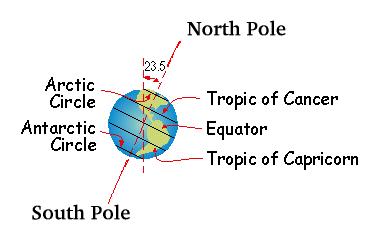 INTRODUCTION
INTRODUCTION
At right is a pictogram of the Earth, with the labels of various locations on the Earth listed. Match up the locations with the descriptions of the sky from that location. More than one location may apply to each description.
| Location | Description of Sky | |
|---|---|---|
| a. North Pole | _________ | 1. The Sun can be seen at the zenith twice during the year. |
| b. North of the Arctic Circle | _________ | 2. North circumpolar stars are seen. |
| c. Arctic Circle 66.5 deg N latitude | _________ | 3. The Sun can be seen at the zenith only once during the year. |
| d. South of the Arctic Circle | _________ | 4. North celestial pole seen at the zenith. |
| e. North of the Tropic of Cancer | _________ | 5. All stars rise and set. |
| f. Tropic of Cancer | _________ | 6. All northern stars are circumpolar. |
| g. South of the Tropic of Cancer | _________ | 7. Celestial poles are seen on the horizon. |
| h. North of the Equator | _________ | 8. South celestial pole is seen at the zenith. |
| i. Equator | _________ | 9. All southern stars are circumpolar. |
| j. South of the Equator | _________ | 10. The ecliptic can be seen directly overhead at local noon on June 21. |
| k. North of the Tropic of Capricorn | _________ | 11. The ecliptic can be seen directly overhead at local midnight on December 21. |
| l. Tropic of Capricorn | _________ | 12. The Sun is at the zenith on March 21. |
| m. South of the Tropic of Capricorn | _________ | 13. The Sun fails to rise above the horizon between March 21 and September 21. |
| n. North of the Antarctic Circle | _________ | 14. Only place on Earth where Pisces and Virgo can be seen at the zenith. |
| o. Antarctic Circle 66.5 deg S latitude | _________ | 15. Location that is closest to the Sun at winter solstice. |
| p. South of the Antarctic Circle | ||
| q. South Pole |